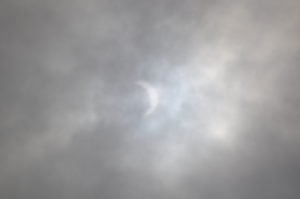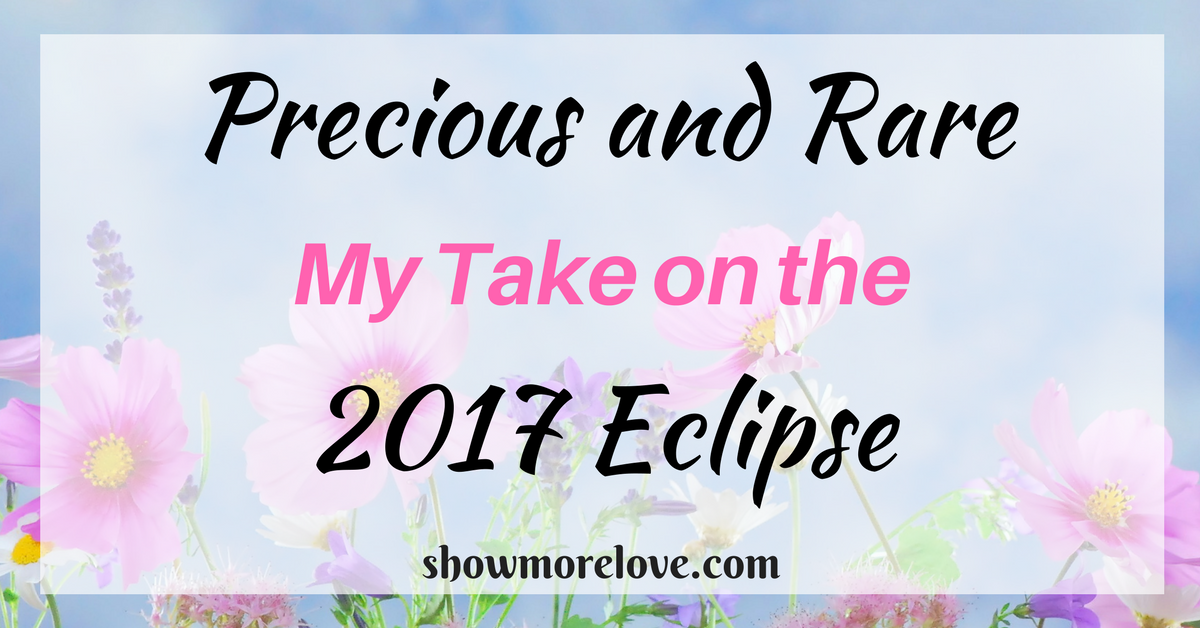August 21st marked the first time in decades a total eclipse of our star was visible across the United States from coast to coast. The path of totality was narrow (70 miles), and I could have traveled 3 hours north to see it, but I chose to stay home. I also forgot to pick up eclipse glasses, so I went to bed the night before with no hope of witnessing the eclipse, which peaked at 93% in my area, other than through a pinhole projector or on television.
The day arrived cloudily and stayed that way. As the time of the eclipse approached, I watched coverage on TV and took note as the light outside dimmed more and more. Taking a quick peek out the window at about 10 minutes to maximum eclipse, I noticed an interesting, patchy area of cloud. I decided to pop outside and to snap a picture with my phone.
 I snapped the picture, and then I looked upward. The clouds suddenly thinned enough to see the almost totally occluded sun diffused just enough by the clouds to view comfortably with the naked eye. The sliver of sun looked ghostly white behind the clouds, but I could clearly see it, so I took a few pictures with my phone and grabbed my trusty Nikon to take more.
I snapped the picture, and then I looked upward. The clouds suddenly thinned enough to see the almost totally occluded sun diffused just enough by the clouds to view comfortably with the naked eye. The sliver of sun looked ghostly white behind the clouds, but I could clearly see it, so I took a few pictures with my phone and grabbed my trusty Nikon to take more.
Off and on for several minutes the eclipse emerged and vanished before the brightening post-eclipse sun became too much, and my camera and I returned to the house to watch on TV those areas lucky to see the eclipse in its total form.
Cool Facts about a Total Eclipse #nerdalert
- According to History’s “The Universe: Total Eclipse” (available on demand), a total eclipse only occurs because “the sun is about 400 times bigger than the moon, but the sun happens to be about 400 times farther away from the Earth than the moon.” Because of this cosmic coincidence, the moon and the sun appear the same size to us in the sky, allowing the moon to precisely cover the disk of the sun and unmask the corona – sometimes . . .
- . . . because the fact that the moon passes directly between the earth and sun doesn’t ensure a total eclipse. The moon has an elliptical orbit, so at times, the moon is a bit farther from the Earth than at other times. When the moon is farthest away, it appears too small in the sky compared to the sun, causing an annular eclipse, which leaves a ring of sun visible.
- The leading theory about the moon’s formation asserts it formed as a result of a collision between the Earth and another planet, named Theia, in the early solar system. The Earth wasn’t destroyed, but the collision blew off part of its crust. That material combined with the remains of Theia to create our moon.
- Scientists estimate that the moon formed less than 20,000 miles from the Earth, and ever since then, it’s been retreating from the Earth. In fact, every year, the moon moves an average of 1.5 inches farther away. Therefore, it makes sense to me that hundreds of millions of years from now, the moon will be too far away for a traditional total eclipse. Instead, annular eclipses will be the norm.
- It also makes sense to me that in the far distant past (hundreds of millions of years ago) the moon would have been too close to the earth to produce a total eclipse that shows the corona. The moon would have been relatively too big compared to the sun for the corona to appear. Any sign of the sun would have been blanked out by the moon. It would completely disappear.
- “The Universe: Total Eclipse” explains that no other planet in our solar system experiences a total eclipse. Furthermore, the preciseness of the necessary distances and alignments would make our total eclipses exceedingly rare if not unique in the universe.
- Only in the past couple of millennia have scientists begun to recognize these facts, and only in the past couple of centuries have they begun to understand them.
What Can We Learn From a Total Eclipse?
This place, this world, our Earth is precious and rare. Total eclipses showcase this uniqueness.
Even rarer is humanity’s ability to contemplate the complexities that give us solar eclipses.
The 2017 eclipse reminded me of our uniqueness of our place in time and space.
I love that!
Show more love. Grow more love.
♥ Teresa

Leave a Reply